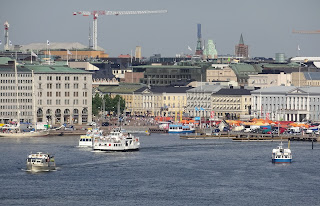My family (father's side) originated in Prussia which doesn't exist anymore. In fact, in that part of the world, several countries have at times been major empires and at other times have disappeared from the map. The history is long (800+ years of well recorded history), complex (independent for only the past 25 years, at the crossroads of invasions from many directions in the past), and the people are still recovering from atrocities in WWII and domination by the USSR until the 1990's. Not your typical tourist destination, but very interesting. If you are headed in that direction, including a visit to the Scandinavian countries is convenient and worthwhile.
With all this in mind I planned a four-week trip. So much information is available on the internet. Additionally, I read some history and current events; where can our time best be spent? Even with four weeks, it is only time enough for a brief sampling of what the region has to offer. First, I booked the international flights; we would arrive in Oslo and depart from Berlin. These cities allowed me to book our flights using only airline frequent flyer miles. Adding Bergen, Stockholm, and Helsinki were easy choices.
Our Baltic destinations were harder choices. I wanted to be able to drive and experience the countryside. My notes suggested that the eastern parts of some of these countries were still undeveloped for tourism: roads, language, accommodations; too questionable for such as us, being completely unfamiliar with the region. But I wanted to see Narva, on the historic border with Russia where battles had been fought for centuries. Tallin is the capital of Estonia while Tartu is the location of Estonia's major university. Riga is the capital of Latvia. Vilnius is the capital of Lithuania and Klaipeda is its major seaport. That leaves out several other attractive choices, but I didn't want a hectic schedule.
Our flight to Oslo, with stops in DC and Manchester, was uneventful. The airport is 30 miles out of town, but, with some help, we managed to buy tickets and board the proper train. Our hotel was a short walk from the train station. Oslo is pretty and a very walkable city; we took advantage of it. Cafes in the pedestrian district, parks, museums, ferry boat rides, and upscale neighborhoods; we stayed busy. One evening we came across a food festival where merchants were giving out samples of many different dishes, enough to provide our dinner. At this time of the year, darkness only lasts about 4-5 hours; sunset at 11pm. Vigeland Park on the west edge of downtown is a huge complex including playing fields and 600 statues, all nudes. The preserved Viking ships are also amazing to think of the excellent craftsmanship with only crude tools.
From Oslo we took the scenic train through snow-capped mountains to the coastal city of Bergen. Bergen, an ancient seafaring port, is the gateway to the fjords. Naturally we took a day trip into some fjords and enjoyed seafood dinners. Bergen is said to be the rainiest city in Europe, and we had drizzle one day, but were still able to take a cog railroad to a peak and walk to overlook the harbor.
From Bergen, we flew to Stockholm. The airport is 26 miles out of the city; we stopped at the Tourist Information booth to learn where to buy tickets and which commuter & subway trains to take to our destination. A bit of a challenge in an unfamiliar city of two million inhabitants and signs in Swedish; their public transit system is complex and all encompassing. The city is spread across 14 islands. We travel light with no checked bags, so it is easy to bring our small suitcases onto the trains. With many high rise apartments, Stockholm is densely populated; we seemed to be in crowds wherever we went, but, of course, we were seeing the tourists sites along with everyone else. One afternoon we traveled to Sigtuna, a coastal village about 35 miles SW by train & bus, which was scenic but still had many tourists. The exhibition of the ship Vasa, which sunk almost 400 years ago, is a worthwhile event to include on your list (of course, I am a boat guy).
Finland is located in the same latitudes as Alaska, and is populated by a rugged people, a place where grandmas go moose hunting in the forest. A knowledge of history helps to appreciate the present. Before WWII, Hitler signed a secret pact with Stalin initiating conflict in this area. Thousands of Finnish children were sent to Sweden to live with Swedish families and be safe from war. A significant number did not have parents to come back to.
Today all students are required to learn three languages: Finnish, Swedish and a third choice which is often English. The Finns, with the help of German arms, were able to stop the Russian army, but, at the end of WWII, part of Finland was awarded to Russia. After a few days we took the fast ferry to Tallin, Estonia. The ferry dock was only two blocks from our hotel, a short walk.














No comments:
Post a Comment